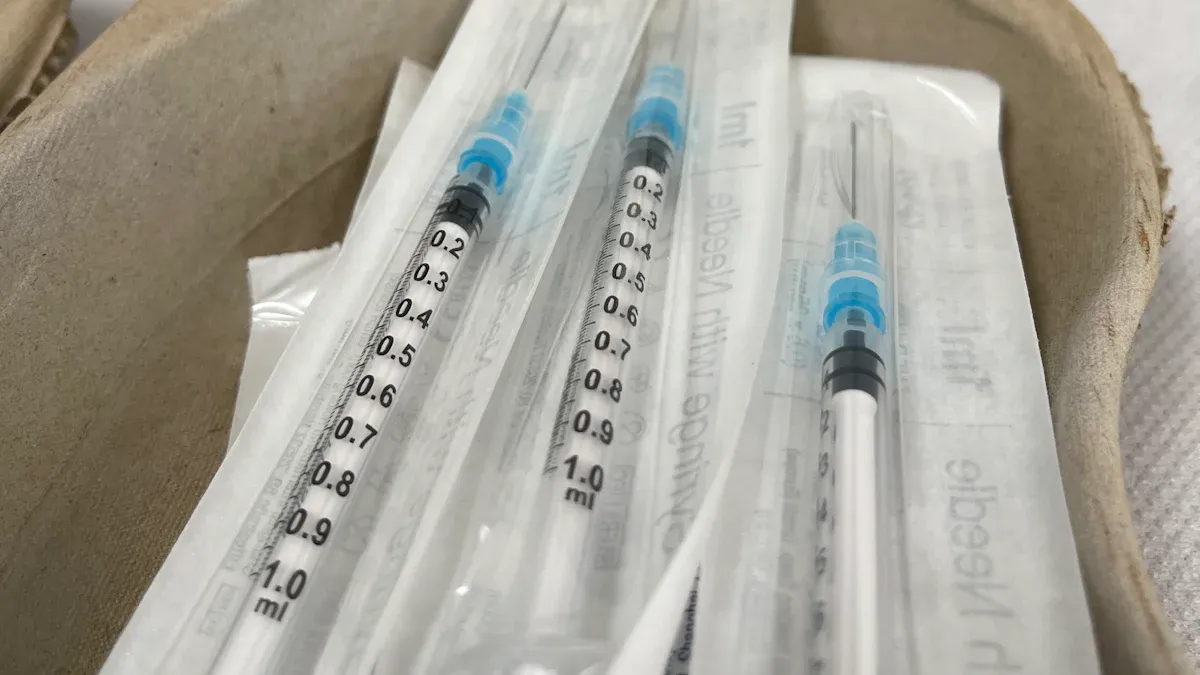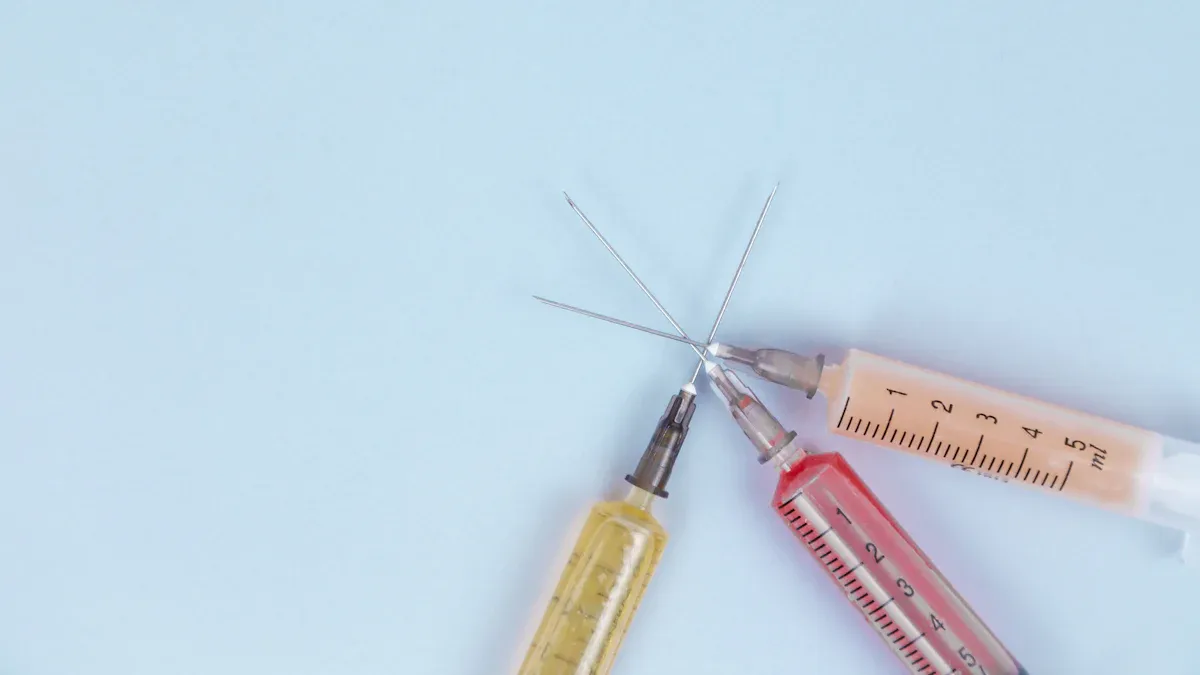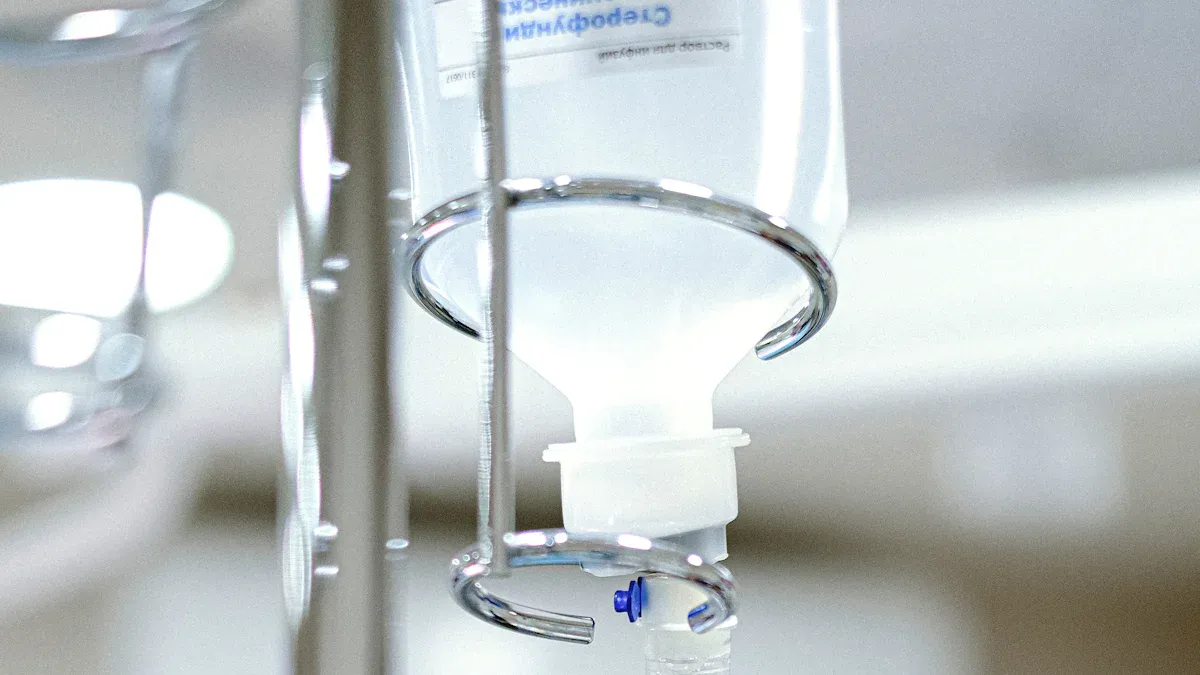A Guide to Selecting PET Heat Shrink Tubing for Medical Use in 2025

Precision and biocompatibility play vital roles in medical device assembly, and PET heat shrink tubing for medical device assembly ensures that devices meet strict performance and safety standards. Recent trends reflect this importance:
The global medical device market is projected to reach $612 billion by 2025, showcasing the growing demand for high-quality materials, including PET heat shrink tubing for medical device assembly.
Sales of Class III medical devices using ultra-thin PET tubing rose 17% in 2023, underscoring the need for precise and biocompatible solutions like PET heat shrink tubing for medical device assembly.
Regulatory updates, like ISO 13485, now require biocompatible materials for medical devices. These changes emphasize the importance of selecting PET heat shrink tubing for medical device assembly that meets these critical requirements.
Key Takeaways
Pick PET heat shrink tubing because it is safe for the body. It follows safety rules and won’t harm human tissue.
Measure carefully. Use tools like rulers or calipers to make sure it fits tightly without stretching.
Choose the right shrink ratio. A 2:1 or 3:1 ratio makes it fit well, reducing gaps and helping devices work properly.
Control the heat carefully when shrinking. Use heat guns or ovens to stop damage and make sure it shrinks evenly.
Test the tubing on samples before using it fully. This step checks if it works well with medical devices.
Key Requirements for Medical Applications
Biocompatibility and Non-Toxic Properties
Biocompatibility is a critical factor when selecting ultra-thin PET heat shrink tubing for medical devices. Materials used in medical applications must not cause adverse reactions when in contact with human tissue. Regulatory frameworks like ISO 10993 mandate rigorous biocompatibility testing, including cytotoxicity and sterilization compatibility. These requirements streamline FDA submissions and ensure patient safety. PET tubing, known for its non-toxic properties, meets these standards effectively.
A study published in the Journal of Medical Materials Research in 2023 highlighted PET's durability under sterilization. After 50 hydrogen peroxide sterilization cycles, unmodified PET showed only a 12% reduction in tensile strength. This resilience makes it ideal for applications requiring repeated sterilization, such as catheters and surgical instruments. Ultra-thin PET heat shrink tubing also provides excellent electrical insulation, further enhancing its suitability for medical devices.
Precision for Medical Device Assembly
Precision is essential in medical device assembly, especially for intricate designs like nerve repair systems. PET heat shrink tubing delivers unmatched accuracy, ensuring a snug fit around substrates without compromising functionality. Customizable dimensions and coatings allow manufacturers to tailor ultra-thin PET heat shrink tubing to specific device requirements.
The following table illustrates the importance of precision in medical applications:
Key Aspect | Description |
|---|---|
Precision | PET tubing ensures reliability and accuracy in medical devices. |
Applications | Vital for nerve repair and other intricate medical procedures. |
Customization | Supports compatibility with complex designs through tailored dimensions and coatings. |
Patient Outcomes | Enhances patient recovery by addressing complex medical challenges effectively. |
Collaborating with experienced manufacturers can further optimize the performance of ultra-thin wall PET heat shrink tubing, driving advancements in medical technology.
Durability Against Sterilization and Environmental Stress
Medical devices often undergo harsh sterilization processes, including autoclaving, gamma radiation, and chemical exposure. Ultra-thin PET heat shrink tubing withstands these conditions without compromising its structural integrity. Its ability to endure extreme temperatures and environmental stress ensures long-term reliability.
The table below highlights key factors influencing PET tubing's durability:
Application Area | Key Factors | Thickness Requirement | Growth Rate |
|---|---|---|---|
Medical Devices | Hermetic sealing, minimal bulk | Below 0.1mm | $12.3 billion by 2028 |
This durability makes ultra-thin PET heat shrink tubing an indispensable component in medical devices, ensuring consistent performance even under demanding conditions.
Selecting the Right Size for Heat Shrink Tubing

Measuring Pre-Shrink Diameter and Substrate Dimensions
Accurate measurements are essential when selecting ultra-thin pet heat shrink tubing for medical applications. The tubing must fit securely around the substrate without stretching or compromising its integrity. To achieve this, manufacturers rely on precise tools and techniques:
Use plug gages to measure the inside diameter (ID) of the tubing. This prevents unnecessary stretching during the measurement process.
Measure the outside diameter (OD) of the tubing with calipers while the plug gage remains inside.
Determine wall thickness after the tubing has fully recovered from heating. This ensures the material meets the required specifications for medical use.
For optimal performance, the tubing should shrink by at least 20% of its supplied size but retain 10% unresolved recovery after installation. For example, an RNF-100 size 1” tubing should recover to a size between 0.55” and 0.80”. Selecting the largest size that fits the application simplifies installation and enhances wall thickness, ensuring durability and reliability in medical environments.
Choosing the Correct Shrink Ratio (e.g., 2:1 or 3:1)
Shrink ratio plays a critical role in determining how well ultra-thin pet heat shrink tubing conforms to the substrate. Common ratios like 2:1 and 3:1 indicate how much the tubing will shrink relative to its original size. A 2:1 ratio means the tubing will shrink to half its original diameter, while a 3:1 ratio will reduce it to one-third.
When selecting a shrink ratio, consider the following:
Choose a ratio that closely matches the final diameter of the substrate. This minimizes gaps and ensures a snug fit.
PET tubing performs better at lower shrink ratios, making it ideal for applications requiring precision.
Avoid using tubing with a diameter more than 15% larger than the substrate to prevent over-shrinking or uneven recovery.
By selecting the correct shrink ratio, manufacturers can achieve a balance between flexibility and structural integrity, ensuring the tubing meets the stringent demands of medical device assembly.
Ensuring a Tight Fit Without Over-Shrinking
Achieving a tight fit is crucial for the performance of ultra-thin pet heat shrink tubing in medical devices. Over-shrinking can lead to material degradation or damage to the substrate, compromising the device's functionality. To ensure a proper fit, follow these guidelines:
Specification | Detail |
|---|---|
Tight fit gap | 15% or less |
Maximum diameter sizing | No larger than 15% above part diameter |
Target shrink ratio | 1.1:1 |
Recovery capability | >20% with proper heating techniques |
The tubing operates effectively within a temperature range of 70°C to 190°C, with an optimal shrinking temperature of 150°C. This allows the material to conform tightly to the substrate while maintaining its structural integrity. Specifying tubing close to the final diameter of the product reduces the risk of over-shrinking and enhances overall performance.
By adhering to these principles, manufacturers can ensure that ultra-thin pet heat shrink tubing provides a secure and reliable fit, meeting the high standards required for medical device assembly.
Temperature Settings for PET Heat Shrink Tubing

Recommended Shrinking Temperature Range (70°C to 190°C)
Ultra-thin PET heat shrink tubing requires precise temperature settings to achieve optimal performance. The recommended shrinking temperature range for this material is between 70°C and 190°C. This range ensures the tubing shrinks uniformly without compromising its structural integrity. Manufacturers often aim for an optimal shrinking temperature of approximately 150°C, which allows the tubing to conform tightly to the substrate while maintaining its durability.
The wide temperature range accommodates various medical applications, from delicate nerve repair systems to robust surgical instruments. For instance, lower temperatures around 70°C are suitable for sensitive components, while higher temperatures near 190°C are ideal for applications requiring maximum shrinkage and strength. Adhering to these guidelines ensures that the tubing performs reliably in demanding medical environments.
Avoiding Material Degradation During Heat Application
Proper heat application is critical to prevent material degradation in ultra-thin PET heat shrink tubing. Excessive heat can weaken the tubing's mechanical properties, reducing its effectiveness in medical devices. To avoid this, manufacturers must follow specific practices:
Apply heat evenly across the tubing to prevent localized overheating.
Use controlled heating tools, such as heat guns with adjustable settings, to maintain consistent temperatures.
Avoid prolonged exposure to high temperatures beyond the recommended range to preserve the tubing's flexibility and strength.
Polyimide tubing, known for its exceptional heat resistance, serves as a benchmark for maintaining material integrity. It resists degradation from harsh chemicals, humidity, and UV exposure, ensuring long-term reliability. Similarly, PET tubing's ability to withstand sterilization processes and environmental stress makes it a dependable choice for medical device assembly. Proper temperature control during heat application extends the tubing's lifespan and ensures consistent performance.
Tools for Precise Temperature Control
Accurate temperature control is essential when working with ultra-thin PET heat shrink tubing. Specialized tools help manufacturers achieve the desired results without damaging the material. Common tools include:
Heat Guns: These devices offer adjustable temperature settings, allowing users to apply heat precisely. Models with digital displays provide greater accuracy.
Ovens: Convection ovens ensure uniform heating, making them ideal for batch processing. They are particularly useful for applications requiring consistent shrinkage across multiple components.
Infrared Thermometers: These tools measure surface temperatures without direct contact, ensuring the tubing remains within the recommended range.
Hot Air Stations: These stations provide localized heating, making them suitable for intricate medical devices with small components.
Using these tools ensures that the tubing shrinks uniformly and maintains its structural integrity. Precise temperature control minimizes the risk of over-shrinking or material degradation, enhancing the performance of medical devices.
Tip: Always test the tubing on a prototype before full-scale application to ensure compatibility with the chosen heating method.
Managing Shrinkage Control in Medical Applications
Radial vs. Axial Shrinkage Explained
Shrinkage in ultra-thin PET heat shrink tubing occurs in two directions: radial and axial. Radial shrinkage refers to the reduction in the tubing's diameter when heat is applied. This property ensures a snug fit around the substrate, making it ideal for medical devices requiring precision. Axial shrinkage, on the other hand, involves the tubing's length contracting during the heating process. Excessive axial shrinkage can lead to uneven coverage or gaps, which may compromise the device's performance.
Manufacturers must balance these two types of shrinkage to achieve optimal results. PET tubing's heat resistance allows it to maintain its structural integrity during this process, ensuring reliable performance in medical applications. Understanding the relationship between radial and axial shrinkage helps manufacturers select the right tubing for specific needs.
Tips for Uniform Shrinkage Across Tubing
Achieving uniform shrinkage is essential for the consistent performance of heat shrink tubing. Uneven shrinkage can result in wrinkles, gaps, or weak spots that affect the tubing's functionality. To ensure uniformity, manufacturers can follow these tips:
Apply heat evenly: Use tools like heat guns or ovens to distribute heat consistently across the tubing.
Control the heating environment: Avoid drafts or uneven surfaces that may disrupt the heating process.
Preheat the substrate: Warming the substrate slightly before applying the tubing can promote even shrinkage.
Monitor shrinkage rates: Measure both radial and axial shrinkage during testing to identify potential issues.
These practices help maintain the tubing's electrical insulation properties and ensure a secure fit around medical device components.
Practical Applications of Ultra-Thin PET Heat Shrink Tubing
Ultra-thin PET heat shrink tubing plays a critical role in various medical applications. Its precision and durability make it suitable for assembling catheters, surgical instruments, and nerve repair systems. The tubing's ability to provide electrical insulation ensures safety in devices with electronic components. Additionally, its heat resistance allows it to withstand sterilization processes like autoclaving and gamma radiation.
For example, in catheter manufacturing, the tubing creates a smooth, biocompatible surface that protects internal components. In surgical instruments, it provides a lightweight yet durable covering that enhances usability. These applications demonstrate the versatility and reliability of ultra-thin PET heat shrink tubing in advancing medical technology.
Addressing Common Challenges in Heat Shrink Tubing
Preventing Wrinkles and Creases During Application
Wrinkles and creases can compromise the performance of ultra-thin PET heat shrink tubing. These imperfections often occur due to uneven heat application or improper handling during installation. To prevent such issues, manufacturers should focus on maintaining consistent heat distribution. Using tools like heat guns with adjustable settings or convection ovens ensures even heating across the tubing's surface. Preheating the substrate can also reduce the likelihood of creases by promoting uniform shrinkage.
Proper handling techniques play a crucial role as well. Avoid stretching or folding the tubing before application. Instead, store it in a flat or coiled position to maintain its structural integrity. By following these practices, manufacturers can ensure the tubing provides reliable mechanical protection and electrical insulation for medical devices.
Ensuring Consistent Shrinkage for Optimal Performance
Consistent shrinkage is vital for the functionality of ultra-thin PET heat shrink tubing. Uneven shrinkage can lead to gaps or weak spots, which may compromise the tubing's ability to provide heat resistance and durability. To achieve uniform results, manufacturers should monitor both radial and axial shrinkage during the heating process. Applying heat evenly and avoiding excessive temperatures helps maintain the tubing's structural integrity.
Using advanced tools like infrared thermometers or hot air stations can further enhance precision. These devices allow manufacturers to control the heating process and ensure consistent results. Testing the tubing on prototypes before full-scale application also helps identify potential issues and refine the process for optimal performance.
Troubleshooting Common Issues in Medical Device Assembly
Challenges such as material degradation or uneven recovery often arise during the assembly of medical devices using ultra-thin PET heat shrink tubing. Simulation software like VEL has proven effective in identifying these issues. For example, simulations have revealed that oversized extruders can cause polymer stagnation and degradation. Optimizing the extruder size based on critical shear stress values—such as 30 kPa for LDPE or 35 kPa for PVC—can prevent these problems.
Additionally, regular inspections of the extrusion process help maintain quality. Monitoring factors like temperature, pressure, and material flow ensures the tubing meets the required specifications. By addressing these challenges proactively, manufacturers can enhance the reliability and safety of medical devices.
Selecting the right PET heat shrink tubing for medical devices requires attention to biocompatibility, precise sizing, temperature control, and effective shrinkage management. Testing tubing on prototypes ensures compatibility and performance. Consulting manufacturers helps tailor solutions to specific medical applications.
Key performance indicators highlight the importance of precision and safety:
Metric | Description |
|---|---|
Fatigue Life | Measures strain amplitudes and fracture probabilities over 10⁷ cycles. |
Tensile Strength | Assesses the maximum load the tubing can handle before failure. |
Residual Elongation | Evaluates the difference in tensile strain between loading and unloading. |
Performance testing uses tools like Midas NFX to evaluate elasticity and adaptability. Flat-type and bending tests ensure superelasticity for complex pathways. Prioritizing these factors enhances medical device reliability and patient safety.
FAQ
What is the best way to measure PET heat shrink tubing for medical devices?
Accurate measurement requires tools like plug gages and calipers. Measure the tubing's inside diameter (ID) and outside diameter (OD) before shrinking. Ensure the tubing shrinks at least 20% of its supplied size while retaining 10% unresolved recovery for optimal fit.
Can PET heat shrink tubing withstand repeated sterilization?
Yes, PET tubing resists sterilization methods like autoclaving and gamma radiation. Studies show it retains tensile strength after multiple cycles, making it ideal for medical devices requiring durability under harsh conditions.
How do manufacturers prevent wrinkles during application?
Wrinkles occur due to uneven heat distribution. Manufacturers use tools like heat guns with adjustable settings or convection ovens to apply heat evenly. Preheating the substrate also promotes uniform shrinkage and reduces imperfections.
What tools ensure precise temperature control for shrinking PET tubing?
Heat guns, convection ovens, infrared thermometers, and hot air stations provide accurate temperature control. These tools help maintain the recommended shrinking range of 70°C to 190°C, ensuring uniform shrinkage and material integrity.
Why is biocompatibility important for PET heat shrink tubing?
Biocompatibility ensures the tubing does not cause adverse reactions when in contact with human tissue. It meets regulatory standards like ISO 10993, making it safe for medical applications such as catheters and surgical instruments.
See Also
The Importance of Ultra-Thin PET Tubing in Healthcare
New Developments in FEP Tubing for Medical Applications
Selecting Optimal Ultra-Thin PET Tubing for Your Needs

